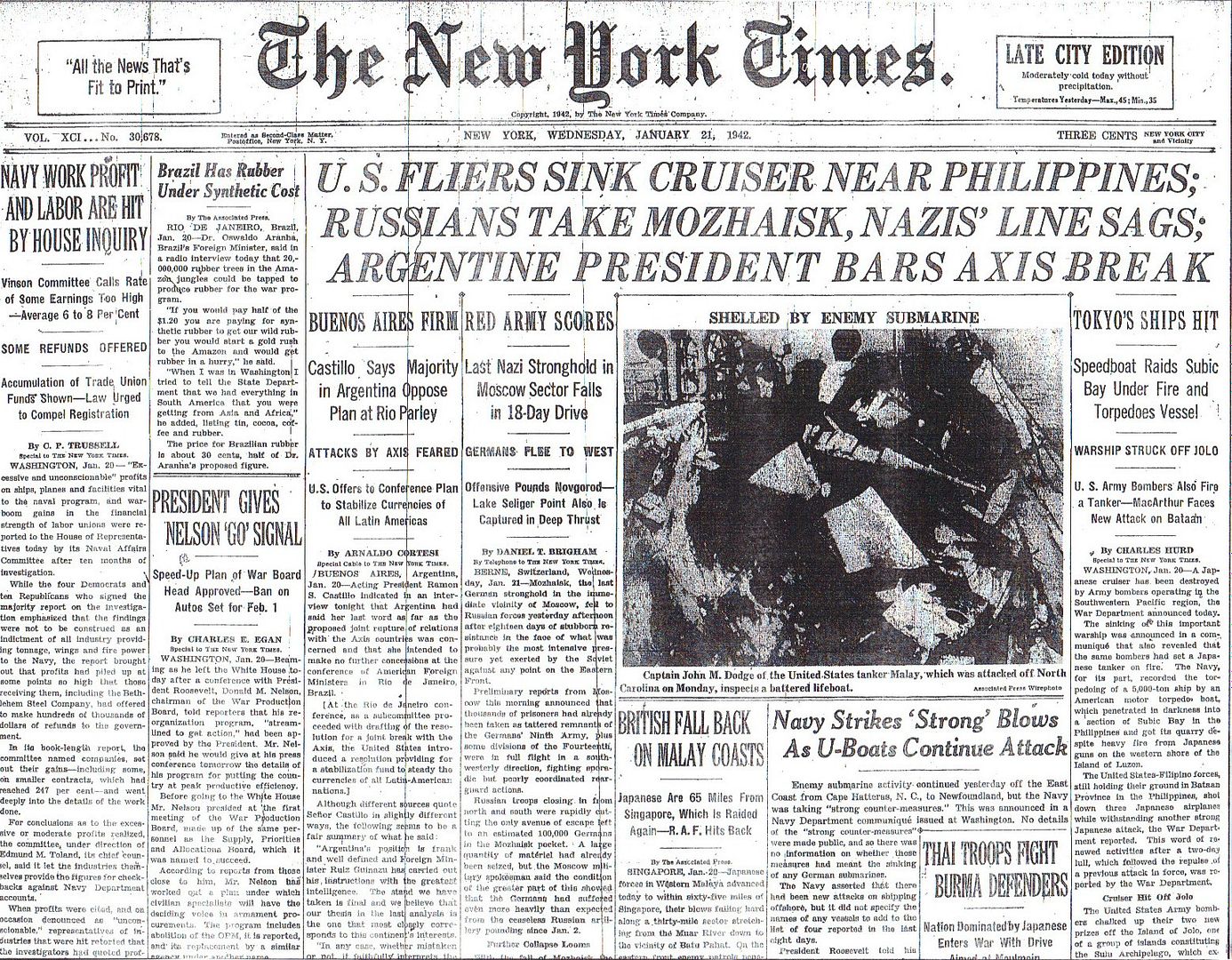
Posted on 01/21/2012 6:26:05 AM PST by Homer_J_Simpson


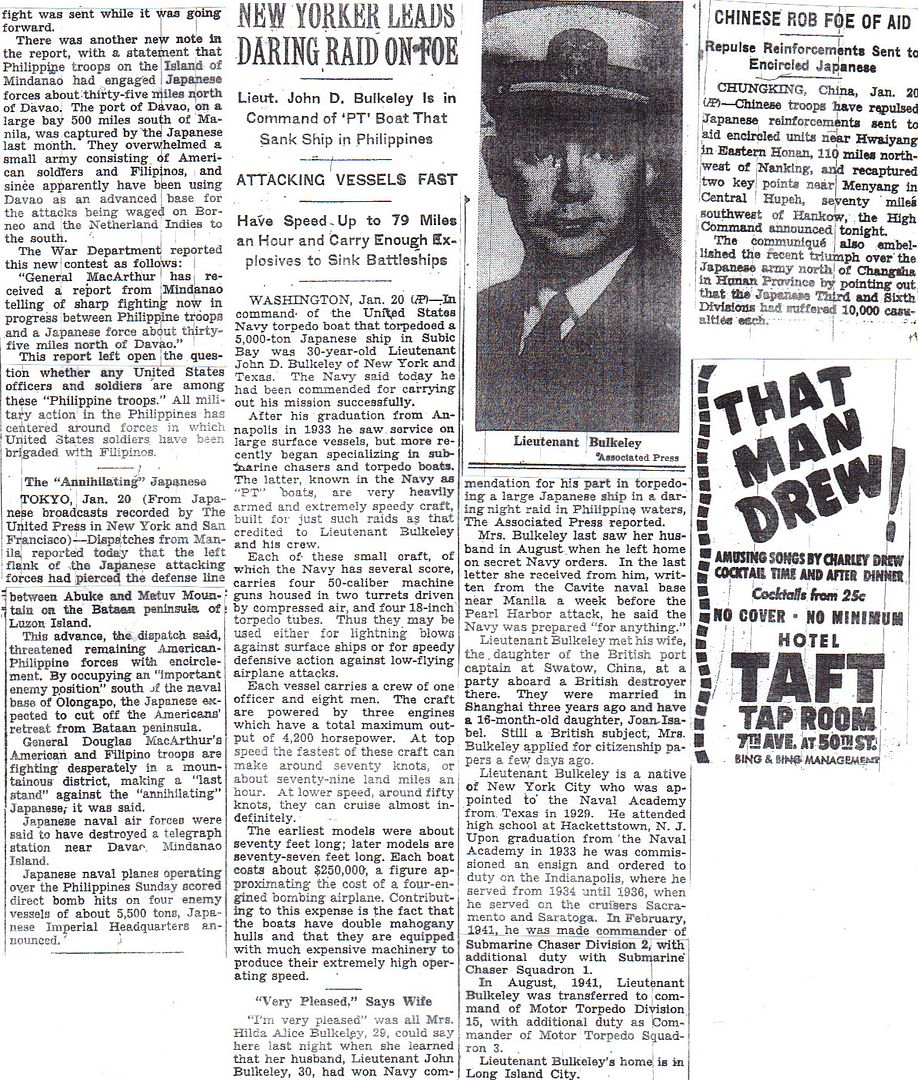
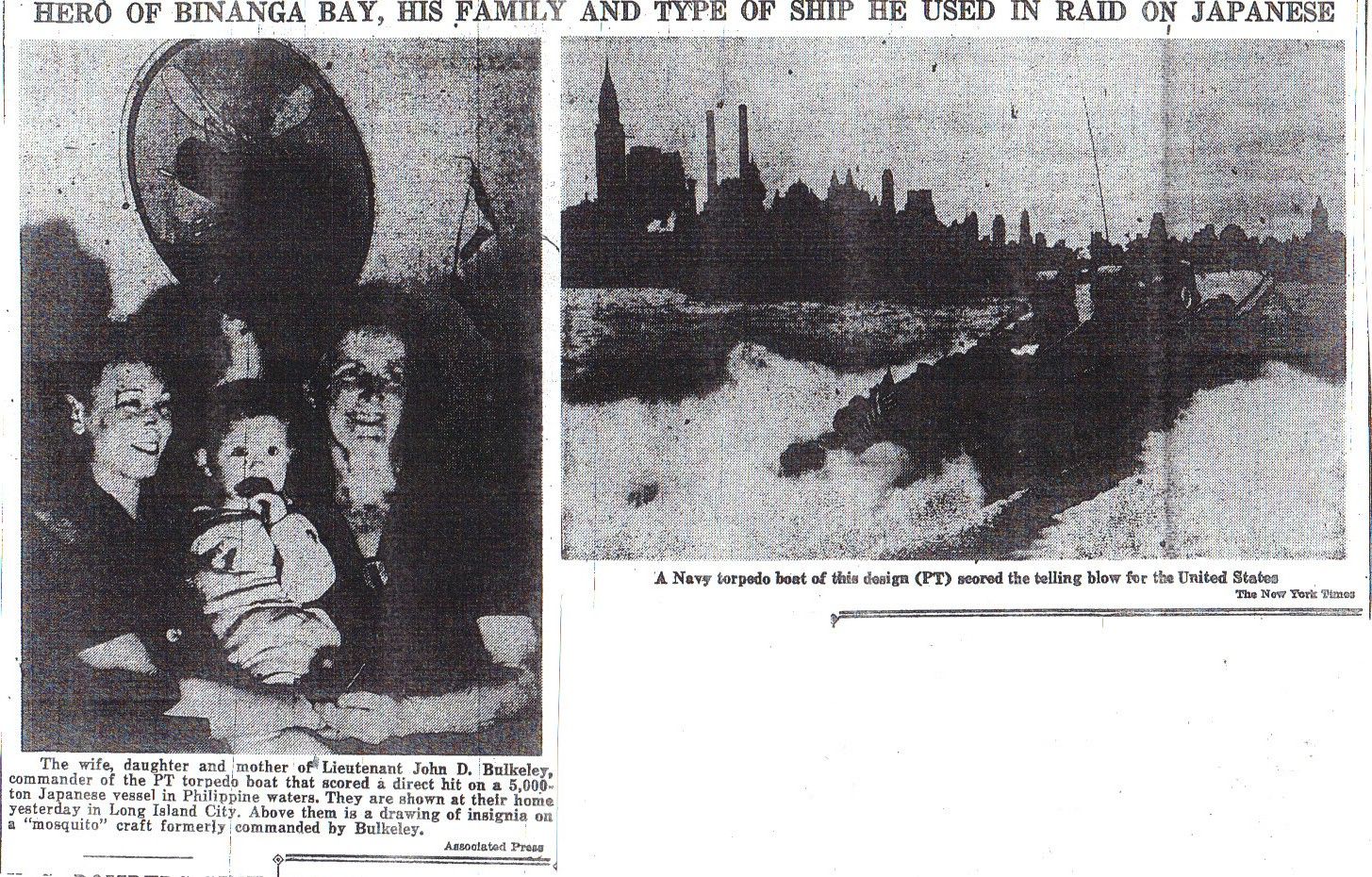
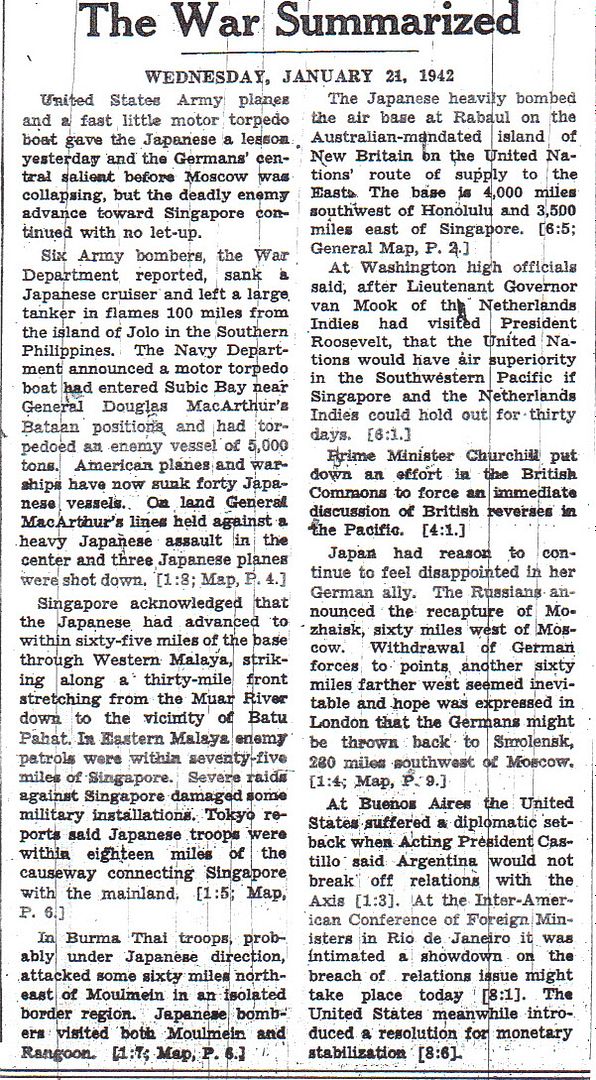
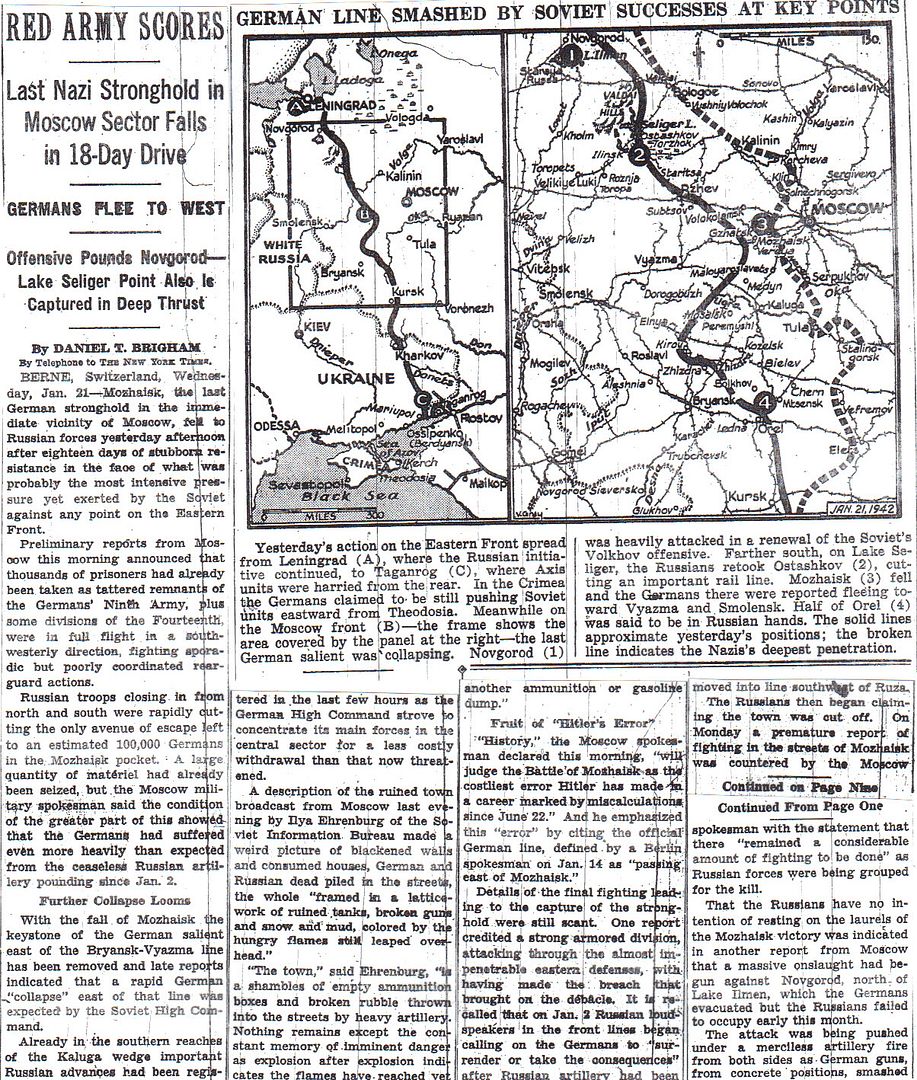
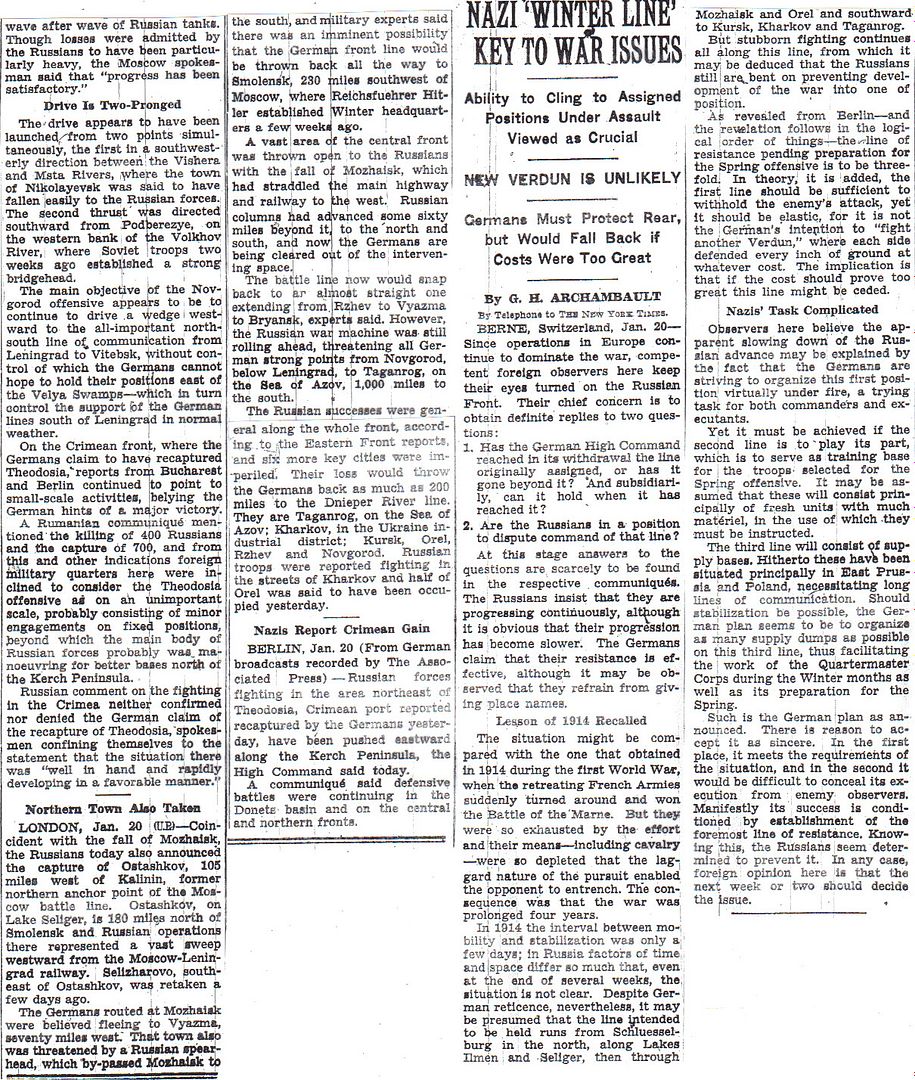
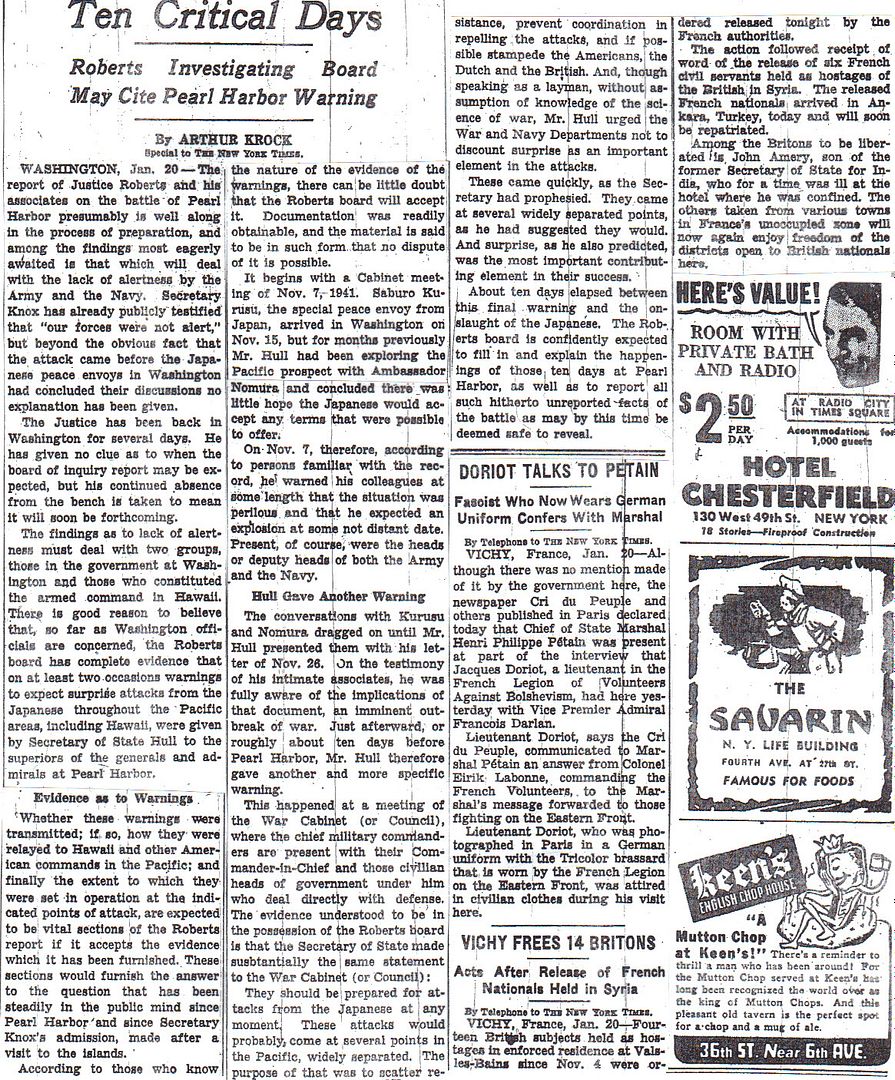
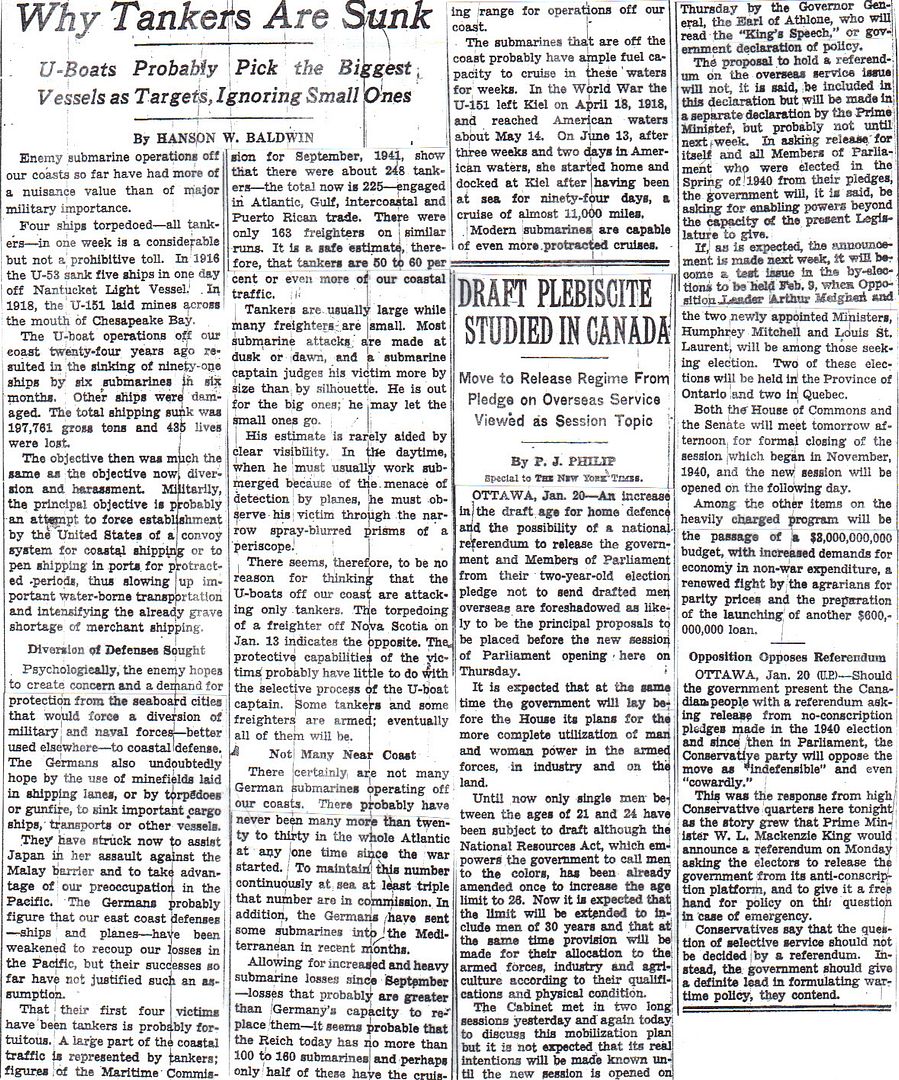
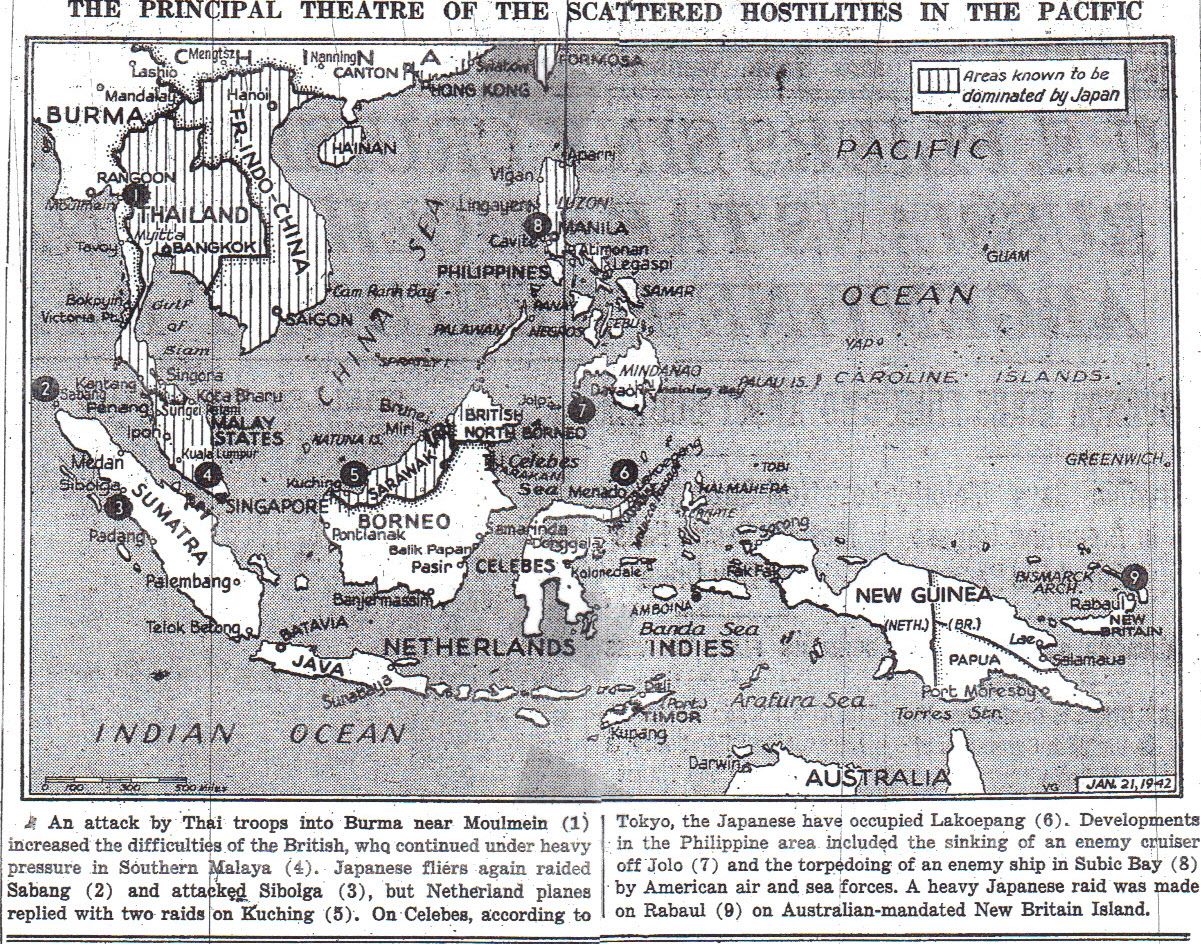

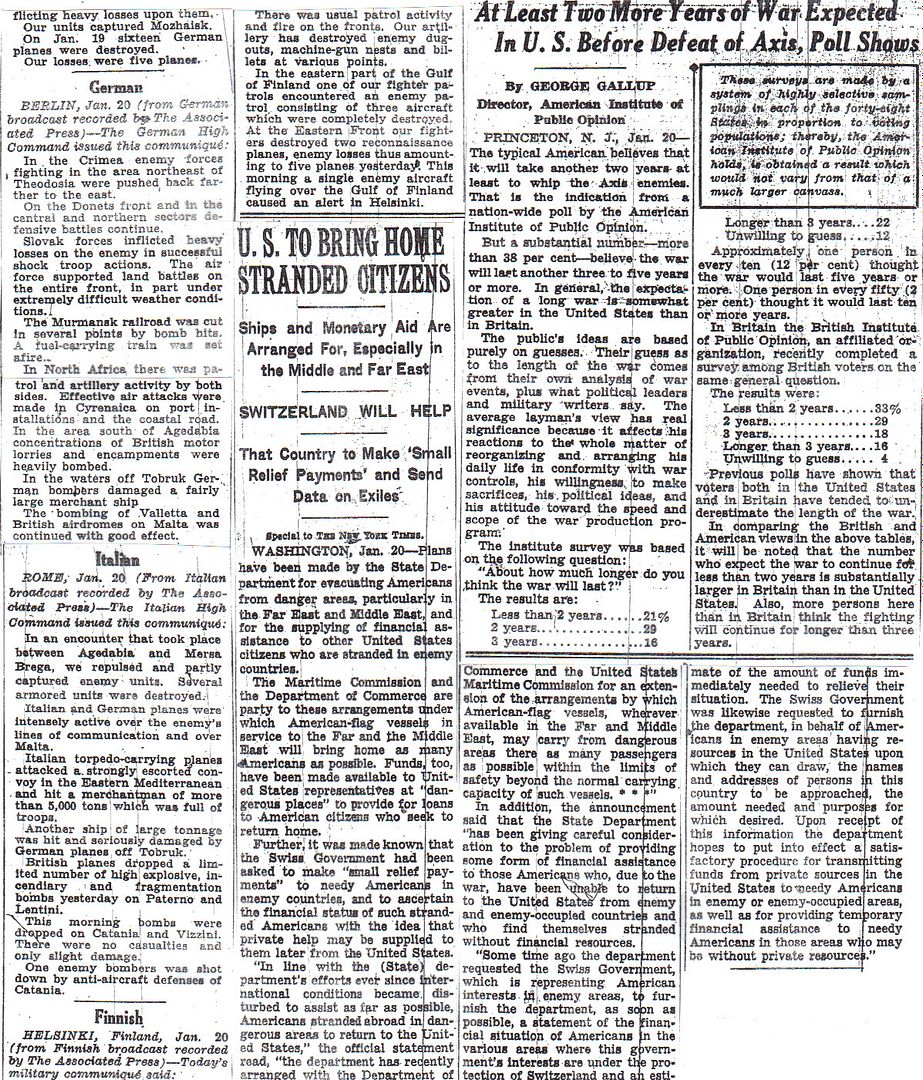
Keep up these posts, please. Fascinating stuff. Including the ads, too (Wowie! $2.50 a night hotel room in mid-town, probably even with a heater).
* Subhead – Lieut. John D. Bulkeley Is in Command of ‘PT’ Boat That Sank Ship in Philippines
In John Ford’s “They Were Expendable” Robert Montgomery played him as Lt. John Brickley. The article doesn’t mention John Wayne’s character.
** Important presentation change. We have decided to ditch “The International Situation” in favor of “The War Summarized.” I mean, what else is happening internationally besides the war?
http://www.onwar.com/chrono/1942/jan42/f21jan42.htm
Stilwell to assist Chaing Kai-shek
Wednesday, January 21, 1942 www.onwar.com
Chiang Kai-shek, his wife and General StilwellIn China... General Stilwell is nominated as Chief of Staff to Chiang Kai-shek.
In North Africa... Rommel’s second offensive begins. Cautious probing reveals that the British are ill situated and the German attacks meet with quick success. The Germans employ 100 tanks in their drive advancing to El Agheila on the inland flank while German and Italian infantry advance along the coast. The British forward defenses are manned by a Guard Brigade and part of 1st Armored Division. The attack when it comes, comes as a surprise.
In Malaysia... the Allied forces begin a retreat south of the Muar River. They have taken heavy losses. The 45th and 15th Brigades have been almost wiped out in the fighting. Japanese air raids on Singapore increase in intensity, as the few British Hurricane fighters are outmatched by Japanese Zeros.
http://homepage.ntlworld.com/andrew.etherington/month/thismonth/21.htm
January 21st, 1942
UNITED KINGDOM: Prime Minister Winston Churchill urges his Chiefs of Staff to consider writing Singapore off and sending reinforcements en route there to Burma. (Jack McKillop)
GERMANY: U-409 commissioned. (Dave Shirlaw)
NORTH AFRICA: Rommel’s second offensive begins.
Within a matter of hours today, the British 1st Armoured Division was in full retreat, racing pell mell across the desert to escape being trapped by German Panzers. A German staff officer described the British flight as “one of the most extraordinary routs of the war.”
No-one - British generals in particular - believed that Rommel could mount a counter-offensive so quickly after being driven back to El Agheila.
The “Desert Fox” had been ordered by Hitler not to attack, and the British were confident that Rommel’s Panzers had been so badly bruised by Operation Crusader that it would be months before the Germans could mount any operation of any size - by which time a British offensive would have driven Rommel out of Africa.
They had not reckoned with Rommel’s ability to recover from a situation and strike back quickly. Two Italian convoys had brought him tank reinforcements - the Royal Navy, its Force K damaged at Malta, had been unable to stop them - and his intelligence knew that the British 1st Armoured Division was new to desert warfare.
With Rommel himself commanding one armoured column, the German tanks rolled at dawn in a two-pronged attack, with strong air support, towards Agedabia in Western Cyrenaica - hitting the British as they breakfasted in the sun. The Panzers are stopping only when they run out of fuel, with Rommel gambling on surprise and his own quick thinking to drive the British eastwards.
Even now, with British tanks fleeing at 25 mph and an entire Indian division facing encirclement, Lieutenant-General Neil Ritchie, the Eighth Army Commander, is apparently convinced that this is no more than a German reconnaissance in force. Ritchie’s subordinates are worried about his indecision, and Major-General Frank Messervy of the 4th Indian Division described the commander’s attitude as “haywire”.
CHINA: The Chinese Government accepts the proposal that U.S. Major General Joseph W. Stilwell act as chief of the Generalissimo’s Allied staff and agrees to give him executive authority over Allied Units. The Chinese 49th Division of the 6th Army, is authorized to move Into Burma. (Jack McKillop)
AUSTRALIA: The destroyer USS EDSALL, Australian corvettes HMAS Deloraine, HMAS Katoomba and HMAS Lithgow sink Japanese submarine HIJMS I-124 off Darwin, Northern Territory. (Jack McKillop)
BISMARCK ARCHIPELAGO: Carrier-based Japanese aircraft from the aircraft carriers HIJMS Akagi and HIJMS Kaga again bomb Rabaul on New Britain Island while aircraft from HIJMS Shokaku and HIJMS Zuikaku bomb Kavieng on New Ireland Island. (Jack McKillop)
CELEBES SEA: In response to the movement of the Japanese convoy sighted the previous day in Makassar Strait, a USN task force (Rear Admiral William A. Glassford), consisting of the light cruisers USS Boise (CL-47) (flagship) and USS Marblehead (CL-12) and four destroyers sails from Koepang, Timor, Netherlands East Indies to engage it. En route, however, USS Boise steams across an uncharted pinnacle in Sape Strait, and suffers sufficient damage to eliminate her from the force. Turbine trouble limits USS Marblehead (the ship to which Glassford transfers his flag) to only 15 knots, so the admiral orders the destroyers (Commander Paul H. Talbot) ahead. (Jack McKillop)
Night surface action at Balikpapan Bay. This was the first naval surface action by the USN during the Pacific War and the first such combat experience since the Spanish-American Civil War in 1898. In response to the sighting of a Japanese convoy in the Makassar Strait, Task Force 5, the striking force of the US Asiatic Fleet, commanded by Rear-Admiral William A. Glassford, sortied from Koepang, Timor, Netherlands East Indies. TF 5 was comprised of the Brooklyn-class light cruiser USS Boise (flagship) and the Omaha-class light cruiser USS Marblehead escorted by four destroyers. Glassford’s normal flagship, the Northampton-class heavy cruiser USS Houston, along with two other destroyers, was absent escorting a troop convoy from Darwin to Singapore. Seven other ‘four-stacker’ destroyers from Destroyer Squadron 29, the screening force for TF 5, were unavailable due to repair and refit requirements. While en route, Boise steamed across an uncharted pinnacle in Sape Strait, tearing a large hole in her hull plating and rendering her unfit for combat. After transferring Admiral Glassford to Marblehead and refueling the other ships in the force, Boise retired to Colombo, Ceylon, then to Bombay, India, and, finally, to Mare Island Navy Yard for repairs. Meanwhile, Marblehead developed turbine problems and was reduced to single-shaft operation, limiting her speed to only 15 knots. Admiral Glassford ordered the Clemson-class destroyers John D Ford, Parrott, Pope and Paul Jones to refuel from Marblehead. Afterwards, he detached them under the command of Cdr. Paul Talbot, CO of John D Ford, who he ordered to attack the Japanese invasion force. Just after midnight on 24 Jan, the four USN destroyers entered Balikpapan Bay at 27 knots. They found 12 Japanese transports and three patrol craft in use as transports at anchor, guarded by one light cruiser and seven destroyers, under the command of Vice-Admiral Nishimura. The Japanese invasion force was also supported by four minesweepers and one patrol boat. The oil production and storage facilities at Balikpapan were burning briskly as the result of Dutch air attacks. The anchored ships were silhouetted against the shoreline but were also occasionally obscured by the large volumes of heavy, acrid smoke from the oil fires. An attack before midnight by the Dutch submarine K-18 resulted in the sinking of the 7,000-ton transport Tsuruga Maru and diverted the attention of the Japanese defenders seaward, just as the American destroyers were entering the bay. Taking advantage of the confusion, the four attackers made two passes through the anchored ships, which were arrayed in two lines. Each ship expended all of its twelve 21-inch torpedoes and then engaged targets with gunfire. The explosions from the American torpedo attacks were thought by the Japanese to come from another submarine attack, which gave the four USN destroyers the opportunity to escape to the south along the coast and rejoin Marblehead. For their efforts, the American attackers were able to sink four transports and one patrol craft, damaging an unknown number with gunfire. Only John D Ford was hit by return fire, a single shell that wounded four men and caused little damage. Although a tactical victory, the results of the engagement have been criticized for not inflicting more serious losses on the Japanese. Part of the problem was the low nighttime visibility in the bay due to the smoke. However, American target identification and fire discipline were poor and excessive speed was maintained during the attack phase, making hits on stationary targets at close range difficult to achieve due to high crossing rates. Seven torpedoes were fired at the minesweeper AM-15 (all missed) and three were fired at the patrol boat PC-37 (two of which hit). This was a major waste of firepower from the only American weapons with adequate killing power. The 4-inch guns mounted on the Clemson-class destroyers were too small to inflict major damage on large vessels. The absence of the American cruisers from TF-5 prevented the tactical setback inflicted on the Japanese at Balikpapan Bay from becoming an operational disaster. Another such opportunity did not present itself during the remainder of the campaign. (Dave Shirlaw)
USN submarine USS S-36 (SS-141), damaged by grounding on Taka Bakang Reef in Makassar Strait yesterday, is scuttled by her crew. (Jack McKillop)
FIJI: The USAAF’s Hawaiian Air Force B-17 Flying Fortresses of Task Group 8.9 fly from Canton Island in the Phoenix Islands to Nandi on West Viti Levu Island in the Fiji Islands. (Jack McKillop)
MALAYA: The withdrawal of defence forces from the Muar and Segamat fronts continues. The Commander of West Force is placed in charge of all troops on the Yong Peng-Muar road and the Muar force is supplied by air. East Force patrols ambush the Japanese force driving on Mersing. The Japanese 55th Regiment captures Endau on the east coast. Australian troops, trapped by a Japanese roadblock at Parit Sulong, try to break through swamp and jungle to reach British lines. Before setting off, they leave their wounded at the roadside, “lying huddled around trees, smoking calmly, unafraid.” The Japanese capture the men and shoot them. (Jack McKillop)
COMMONWEALTH OF THE PHILIPPINES: In the II Corps area on Bataan, the Japanese continue preparations for an offensive, massing their assault forces on extreme western flank of the corps; the Japanese also contain the further attempts of the Philippine Division to restore the western flank positions. In the I Corps area, a small enemy force, having circled about the eastern flank of the corps, reaches West Road in the area 4 miles (6,4 kilometres) east of Mauban and blocks it, cutting off the 1st Division troops along the main line of resistance from forces to the south. Forces that can be spared from other sectors attack the Japanese block from the north and south but are unable to reduce it. (Jack McKillop)
USAAF Far East Air Force B-17 Flying Fortresses based on Java stage through Del Monte Field on Mindanao Island to attack Japanese targets in the Philippines. Three aircraft are badly damaged by Japanese fighters. (Jack McKillop)
BURMA: Japanese forces begin a drive on Moulmein.
CANADA: RCN MTBs TM-22 to TM-29 cancelled after being ordered for the Netherlands. Four served in USN as PT-368 to PT-371.
Minesweeper HMCS Sarnia launched. (Dave Shirlaw)
U.S.A.: General George C. Marshall, Chief of Staff, U.S. Army, advises President Franklin D. Roosevelt that the Army expects the Japanese to attack Dutch Harbor on Unalaska Island in the Aleutian Islands, Territory of Alaska, at any time. The president orders that a plan to establish a striking force in Aleutian Islands be created and executed by the summer of 1942. (Jack McKillop)
Count Basie and His Orchestra recorded the song ‘’One O’Clock Jump’’ in New York City for Okeh Records. (Jack McKillop)
Submarine USS Greenling commissioned. (Dave Shirlaw)
ATLANTIC OCEAN:
At 2221, motor tanker Alexandra Høegh was hit by two torpedoes from U-130, broke in two and sank at 40°54N/66°03W south of Shelburne, Nova Scotia. All hands survived and were rescued after 36 hours.
At 1843, U-203 fired a spread of four torpedoes at steamer of estimated 8000 tons, heard a detonation after 6 minutes 52 seconds and thought that the ship sank. Apparently, the North Gaspe, a Canadian ship under charter by the US Army Transport Service, was damaged by the explosion of a torpedo near the ship about ten miles south of Cape Rose, but managed to reach port safely and was repaired. On board were a US Army gun crew and a communication unit.
At 1922, the unescorted SS Belize was torpedoed and sunk by U-754. There were no survivors. 17 Norwegians, 5 Swedish, 1 Dane and a mess boy from British Honduras were lost. On 24 January, corvette HMCS Spikenard found a water-filled lifeboat bearing her name and four bodies 25 nautical miles east of St John’s
U-754 sank SS William Hansen 45.56N, 52.47W - Grid BB 6682. (Dave Shirlaw)
"Jews in the Vilna (Lithuania) Ghetto establish the Unified Partisan Organization to resist Nazi terror."
"Wannsee, outside Berlin, was a beautiful location, and the leaders of the Third Reich met there frequently, most importantly for the infamous January 1942 conference.
This photo shows some of the leaders of the Third Reich's immense police apparatus.
From the left they are: Kurt Daluege, head of the Order Police; Karl Wolff, chief of Heinrich Himmler's personal staff; Himmler, head of the SS; Captain Bonin of the Order Police; Field Marshal Erhard Milch; SD chief Reinhard Heydrich, who was put in charge of implementing the "Final Solution"; and Friedrich Wilhelm Krüger, chief of police in the Generalgouvernement."
Disclaimer: Opinions posted on Free Republic are those of the individual posters and do not necessarily represent the opinion of Free Republic or its management. All materials posted herein are protected by copyright law and the exemption for fair use of copyrighted works.